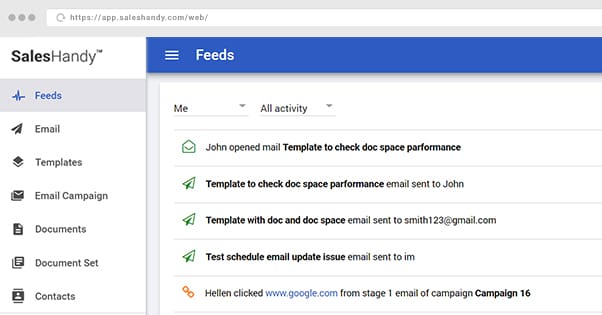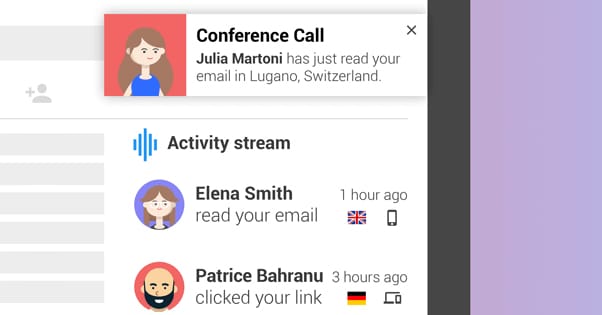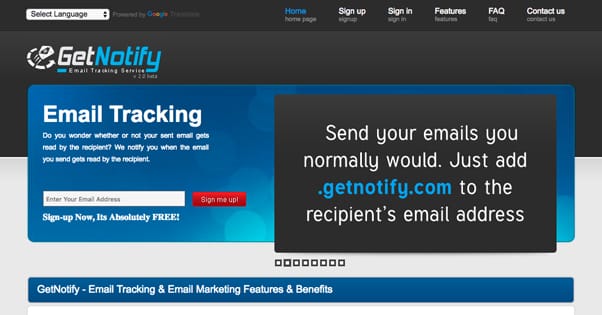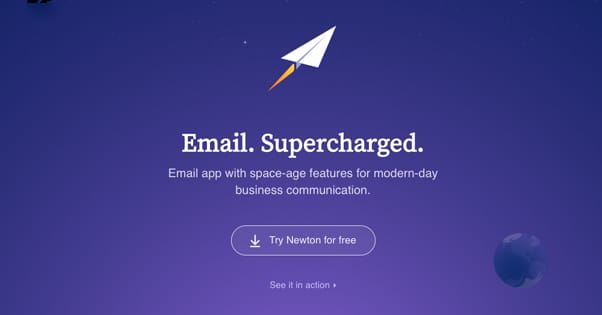List of Free Alternatives to YesWare to Track Email Opens

In the dark ages of email marketing, you could build an email list and you could send your messages, but you had little way to track anything about them. You could see when people clicked your links, but you had no way of knowing how many people opened your emails and proceeded to ignore them. In other words, you couldn’t know open rates or accurate clickrates.
These days, we’re blessed to have a wide variety of tools to use for tracking just about every aspect of your email. YesWare is one such app, but there are plenty of alternatives.
What is YesWare?
YesWare is an email tracking app aimed at businesses both large and small. It tracks your emails when you send them, and tells you information about who is opening the emails, who is clicking to view attachments or links, and if they’re being marked as spam or going to a spam box automatically. The app also has scheduled sending for emails, so you can work tonight and send next week, and you’re not beholden to whatever time you can fit into your schedule. YesWare also has some basic email templating options in case you feel like some canned responses are a good idea. They have a calendar function as well, to book meetings and manage schedules. Email campaign follow-ups and integration with SalesForce round out the feature list.
As far as pricing is concerned, YesWare is far from free. Their basic plan costs $12 per user per month and gets you real time email tracking, analytics, templates, scheduling, reminders, and the calendar features. For $25 per user per month you also get campaign management, more templates, team permissions, and central billing. The enterprise version is $55 per user per month and gets you the SalesForce integration and CRM sync options.
All of this is fine, but you know what’s even better? Free tools. You might not need everything YesWare provides, and you certainly don’t want to pay those kinds of rates for it when you can get similar tools for nothing at all. Let’s look at the free email tracking tools out there and see how they stack up.
1. SalesHandy
SalesHandy is the first option on our list. It’s a paid service, but it has a free package. It’s aimed at individuals, but it can still work fine for small businesses. You get email scheduling, integration with both Gmail and Outlook, and some basic email templates. You don’t get many of their additional features, like campaign tracking, document tracking, team management, or CRM copy.
Perhaps the biggest limitation of SalesHandy as a free app is that you only get a limit of 15 recent records in your activity tracking. All of the paid plans – which start at $7 per month – are unlimited in their tracking.
Overall, the free package of SalesHandy is perfectly viable if you’re interested in email tracking in passing, or if you’re using YesWare primarily for the email scheduling function. If you want detailed and historical analytics, you’ll probably want to look elsewhere, unless you’re keen on monitoring your 15 records at all times and copying them down to your own analytics suite.
2. Gmelius
Clearly inspired by Gmail, Gmelius is an email CRM that is integrated directly into Gmail, the Google suite, or Inbox. It doesn’t hook into Outlook, though, so if you’re using any platform other than Google, you’ll be disappointed here.
Gmelius is, again, a paid app with a free plan. The free plan gives you unlimited email tracking, though, so if that’s your primary goal it’s a good app to use. You get scheduling functions with send later, though it’s slightly limited, in that it’s restricted after the first two weeks. You can integrate with one CRM for some limited functionality. You also get a collaboration Kanban board and some email templates, if that’s your thing.
Gmelius tracking is actually quite robust. You can identify your most engaged leads and send timed follow-up messages to arrive at just the right time for individual sets of users. You can even use notifications for when a message is opened to send a follow-up. You get statistics in general, of course, and activity streams to see how things are going in real time.
The primary drawback of Gmelius is that it’s limited to Gmail as a platform. If you’re stuck using Outlook or a different email system, you’re not going to be able to use Gmelius.
3. MailTrack
MailTrack is similar to Gmelius in that it’s limited to only Gmail, even if it works with every browser. It’s extremely lightweight, however, and doesn’t bother you with deep analytics or scheduling apps or anything else you don’t want.
All MailTrack does is adds two checkmarks next to each email you send, with an entry for each person you send them to. When a person opens the email, one of the checks turns green. If they ever go back and open it a second time, the second mark turns green, so you can see both when it was originally opened and when it was opened most recently. That’s pretty much it!
Well, of course they need to make money somehow, and they have two ways to do it. The first is that the free plan adds a “sent with MailTrack” signature to your messages. This can be slightly disruptive and, with a name that on the nose, definitely lets your subscribers know they’re being tracked. I mean, there’s a passive understanding that every company email is tracked, but you don’t need to come right out and say it all the time. For $2.50 per month, you remove that signature.
They also have plans starting at $5 per month which give you all the extra baggage I was just talking about. They have activity tracking, an Android app, a dashboard, daily reports and reminders, if that’s your thing. It is, again, limited to Gmail and Android, so if you’re on a different platform, you’ll need to look elsewhere.
4. HubSpot Sales
Also known as Sidekick, this HubSpot-branded app is another app that is completely free and tracks email open rates, times, and attachment opens.
While HubSpot sales is free, it’s also more robust than a lot of other competitors. It has lead management and integration with a bunch of other apps, including everything from Outlook and Gmail to Zapier.
HubSpot is one of the biggest names in outbound marketing, and as such, you can trust to the quality of their offerings. The free version of Sales gives you a stream of the most recent 200 email opens, some VOIP calling features, a meeting system, some canned email responses and templates, and option access to the HubSpot CRM. You can, of course, bump up limits and access more tools, like email sequences, live chat features, and more for a starting price.
That starting price is, well, $50 per month, easily the most expensive on this list. The fact is, HubSpot is aimed at more corporate-level customers, and their free offerings are bait to get someone to test them out. It’s not really aimed at small businesses, even if you can use their free trials as such.
5. WhoReadMe
WhoReadMe is a very simple and somewhat primitive app that tracks email open rates, and nothing else. It’s completely free and unlimited, but has three major drawbacks.
The first drawback is setup. You need to send email through their server in order for it to be tracked. In order to do so, you need to jump through some hoops setting it up, and forward your email through their domain. This might be more effort than you want to go through, though it’s not that much different from other trackers.
The second drawback is appearance. When you send through their servers, you append their email domain to your own. You essentially start sending email from username@gmail.com.whoreadme.com This extra domain can often cause a loss of trust, since many people are trained to look at domains and ignore emails that don’t come from a trusted domain. It introduces a lot of potential vectors for abuse.
The third drawback is that WhoReadMe does not guarantee complete accuracy with their tracking. This isn’t all that uncommon, of course. Every email tracker requires some tracking code to identify if an email has been opened or not, and a lot of adblockers and noscript apps block that tracking. No tracker is going to be completely accurate; WRM is just a bit more honest about it.
It’s completely free, though, so there’s no harm in trying it out.
6. GetNotify
Covering this one in brief because it’s very similar to WhoReadMe, except they’ve monetized it fairly aggressively. The free plan only allows you to send up to five emails per day.
You can “donate” to their cause to get more credits for email sends, either $12 or $20 per six months, which bumps you up to either 100 or 700 tracked events per month with no daily limit. It’s still pretty low, though, and the fact that the free plan is only five emails makes it basically useless to businesses.
7. NewtonMail
One of the more full-spectrum email managers, Newton has a handful of different tools that can help with email management. Read Receipts are the primary feature, telling you when your emails have been opened and read, with optional notifications for follow-up emails.
They have an inbox filtering system that helps you, presumably, focus on the messages coming from subscribers that are most relevant. It’s always tricky to get a filter configured just the way you want, though, so be careful with this. A “Snooze” feature allows you to essentially push an email out of your inbox and have it re-delivered later when you’re ready to deal with it.
They have integrations with other productivity apps, which can be quite nice to have. They can hook into Todoist, Evernote, Trello, Asana, and other apps for saving emails as tasks.
Like many tracking apps, Newton will build and maintain a sender profile for the people on your list. You can gradually build up information about the people who open your messages and, more importantly, the ones who respond.
They have a send later feature, of course, since email scheduling is as important as ever. Relatedly, they have an undo send button, to pull back emails you may have sent in error or with misinformation or typos. It’s not unlimited, but it can help.
Of course, Newton has the drawback of being free for a limited time. It’s really cheap once you run out of that trial period, cheaper than YesWare for most of the same features, but it’s not completely free.
8. BananaTag
Your guess is as good as mine as to why email tracking needs to be banana themed, but hey. To each their own, I guess. BananaTag’s email tracking works with both Gmail and Outlook. It shows you read receipts and sends you notifications when someone opens them, as well as when someone clicks a link or opens an attachment within.
They don’t append a dumb domain name to your messages either, eliminating that security concern. You have a dashboard with your analytics, too. Of course, they’re limited in their free plan, again to a meager 5 messages per day. You only get open tracking for free, and only basic notifications, making this more of a sample of a real app than a full useful tracking app.
There are plenty of other paid tracking apps out there, but now I pose the question to you: do you use a free email tracker, and if so, what’s your favorite? I’d love to hear from you.










Hi, I used MSGTAG for many years until it stopped working ~ April 15 2019. I used the paid-for version, MSGTAG-Status, and love it’s simple operation with many email clients. Do you know this program? If, “yes”, do you have equivalent program or, dare I ask (!), do you know of another program with the same features?? Thank you, kind regards, John